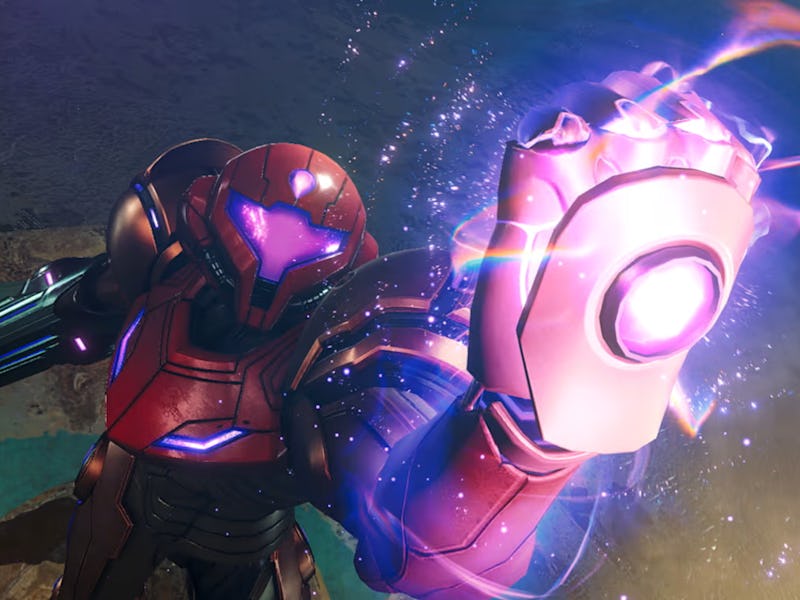Metroid Prime 4 Will Make You Wonder Why The Series Ever Paused
Psyche up.

It’s been 18 years since a Metroid Prime game graced a Nintendo console, and its absence has been felt. Retro Studio’s first-person conversion of the Metroid formula is regarded as one of the greatest trilogies in gaming history, and for good reason. Its atmospheric planetary exploration, satisfying item-based progression, and fun combat are a timeless combination that feels like nothing else in Nintendo’s treasured library.
That’s also why it’s so surprising that we’ve had to wait this long for the fourth game. Thankfully, what I’ve played of Metroid Prime 4: Beyond suggests that the long wait will have been worth it. Nothing I saw during my 90-minute session strayed from what came before. Save for a few new abilities, I was rarely surprised by Beyond, so long-time fans should know exactly what they’re getting. But after nearly two decades between releases, there’s something comforting about returning to Nintendo’s space opera.
According to Nintendo, Beyond marks the start of a brand-new story. While the 2002 original, 2004’s Echoes, and 2007’s Corruption unraveled the mystery of Dark Samus, this game brings back antagonist Sylux, a rival bounty hunter last featured in the obscure DS game Metroid Prime Hunters.
My play session was heavy on story. Samus lands on a remote planet home to an extinct ancient alien race that foresaw the arrival of the Galactic Federation bounty hunter and sees her as a chosen one who will keep their spark alive. There’s more going on that I’ll let players discover for themselves, but what surprised me most was the fact that a companion joined Samus during the adventure. Myles MacKenzie is a talkative and clumsy Federation technician who adds a bit of levity to the game’s otherwise moody vibe.
Thankfully, MacKenzie never crossed the line into overbearing or annoying, which keeps you feeling isolated. There’s still a sense that you’re somewhere few people know about, and exploring these tightly designed environments feels like you’re foraging through an untouched frontier. As I wandered, I split my playtime between the Joy-Con mouse controls and the Pro Controller, ultimately settling on the traditional controller. While the mouse controls work like a charm, I found gripping the thin Joy-Con for long periods of time wasn’t comfortable.
Samus’ new psychic abilities are the highlight of her arsenal.
Speaking of exploring, Beyond continues the series' penchant for fun navigation. In typical Metroid fashion, I obtained abilities that granted me access to new areas and allowed me to be more effective in combat. The old standbys were all here: obtaining missiles let me destroy amber walls that encased switches and passageways, while bombs let me clear blockages and jump higher in morph ball form. The abilities that broke away from this familiar mold were the psychic powers Samus now has access to, like a telekinetic power used for opening specific doors and moving objects around.
The best of these abilities, however, is the Control Beam, which slwos down time and lets Samus control a projectile of swirling energy with her mind (think the remote Batarang from the Arkham games) allowing her to reach otherwise inaccessible places. This ability was how some of the demo’s best puzzles manifested. I used it to power three alien switches simultaneously. I used it to activate a switch on the other side of a jammed door. Best of all, it was incorporated into a fight with a boss whose weak points were only vulnerable to this kind of purple psychic energy.
The psychic abilities didn’t stop evolving there. In the closing moments of my demo, I gained the ability to make Psychic Bombs in morph ball form that I could then move around in suit form using my telekinesis. It’s clear that we’ll see some ingenious puzzles that incorporate Samus’ new power, and my demo left me dying to play more.
Disappointingly, our demo did not let us use Metroid Prime 4’s newest addition, Vi-O-La.
My only criticism is that it feels like the series has barely advanced since we last saw it. Beyond’s art style is gorgeous, but it won’t be taking home any technical awards. The Switch 2 version had plenty of blurry, low-res textures, even on Samus’ Power Suit. It’s far from a deal breaker, but I wasn’t left thinking that the game is a significant improvement over its 18-year-old predecessor.
And as intriguing as the world and level design were, this was still just more Metroid Prime. That’s far from a bad thing, especially when there hasn’t been a new game in nearly two decades. But it was ultimately just more of what you’d expect. It’s worth nothing, however, that the demo didn’t let us play any of the Vi-O-La gameplay sections, which will see Samus riding a bike across huge expanses. Depending on how they’re incorporated, this could be the new wrinkle Beyond needs to feel fresh.
Metroid Prime 4: Beyond is the Switch game players have waited the longest for, and based on what I played, it’s a worthwhile entry for the series. While its troubled development has ultimately resulted in a game that doesn’t stray too far from the near-perfection that came before it, that familiarity doesn’t make me any less excited to play more when it’s released early next month.